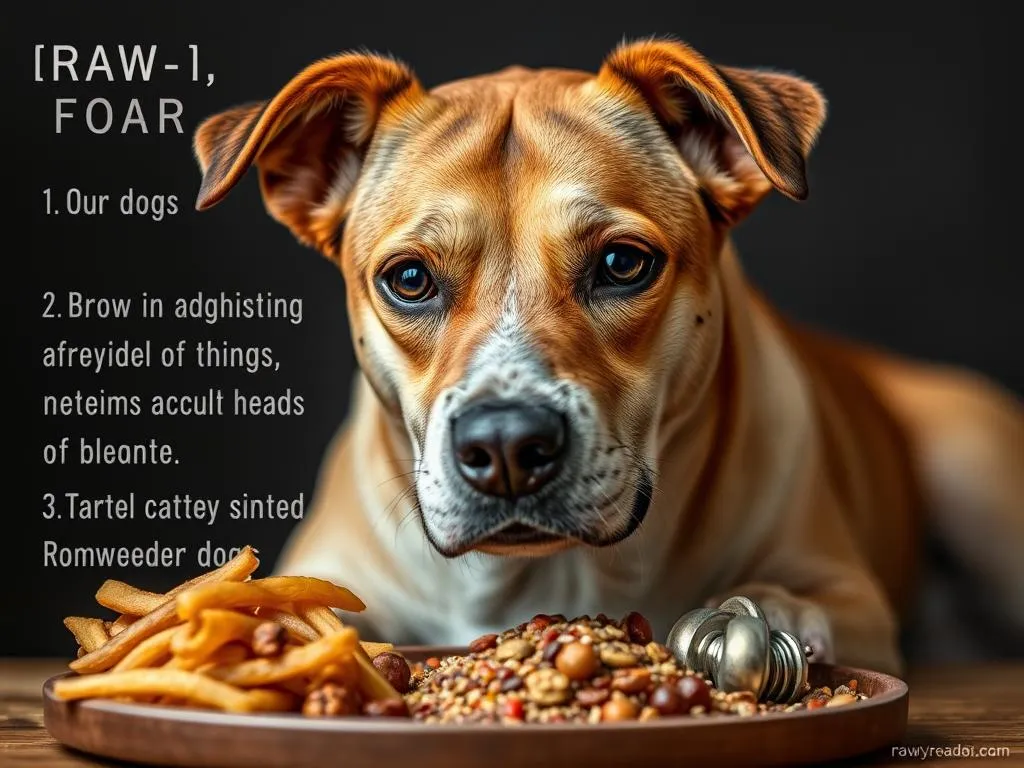
Introduction
Dog nutrition is a crucial aspect of pet ownership that directly impacts your furry friend’s health and wellbeing. As a responsible dog owner, understanding the various diets available is essential, especially the growing trend of raw dog food. This blog post focuses on raw dog food rules, providing insights into how to safely and effectively implement a raw diet for your canine companion.
Raw dog food, often referred to as a “biologically appropriate raw food” (BARF) diet, involves feeding dogs uncooked meat, bones, fruits, and vegetables. In recent years, raw diets have gained popularity among dog owners seeking to enhance their pets’ health through more natural feeding practices. However, it’s important to follow specific rules to ensure safety and nutritional balance.
Understanding Dog Nutrition
Basic Nutritional Needs of Dogs
A balanced diet is vital for dogs, encompassing essential nutrients such as:
- Proteins: Critical for growth, repair, and overall health. They should make up a significant portion of a dog’s diet.
- Fats: Provide energy and aid in the absorption of fat-soluble vitamins. They also contribute to healthy skin and coat.
- Carbohydrates: Offer a source of energy and can aid in digestive health, although they are less crucial than proteins and fats.
- Vitamins and Minerals: Essential for various bodily functions, these nutrients support the immune system, bone health, and many other processes.
The nutritional needs of dogs can vary significantly based on factors such as age, breed, and activity level. Puppies, for instance, require more protein for growth, while senior dogs might need fewer calories to maintain a healthy weight.
Common Myths About Dog Nutrition
There are many myths surrounding dog nutrition that can lead to confusion among pet owners:
- Grain-Free Diets: Many believe that grains are harmful to dogs. However, most dogs can digest grains without issues. The key is to choose high-quality grains if included in the diet.
- All-Natural Claims: Just because a product is labeled as “natural” does not mean it is the best choice. Always review the ingredient list and nutritional content.
- Raw Diets vs. Commercial Dog Food: Some people think that raw diets are inherently better than commercial options. While raw diets can be beneficial, they require careful planning and adherence to specific rules.
What is Raw Dog Food?
Definition and Components
Raw dog food encompasses a diet that consists primarily of uncooked ingredients like raw meat, bones, fruits, and vegetables. The most popular raw feeding methods include:
- BARF (Biologically Appropriate Raw Food): This diet emphasizes a mix of raw meat, bones, fruits, and vegetables, aiming to replicate a dog’s natural diet.
- Prey Model: This approach focuses on feeding dogs whole prey items or portions that mimic what a wild dog would consume.
Benefits of Raw Dog Food
Transitioning to a raw dog food diet can offer several health benefits, including:
- Improved Coat Condition: Many owners report shinier, healthier coats in dogs fed raw diets.
- Enhanced Digestion: Raw diets often lead to firmer stools and better digestion.
- Higher Energy Levels: Dogs may exhibit increased energy and vitality, thanks to more natural, whole-food ingredients.
- Reduced Allergies: Some dogs with food sensitivities or allergies benefit from the elimination of fillers and grains found in commercial dog foods.
Raw Dog Food Rules: Essential Guidelines
Rule 1: Balance and Variety
One of the most crucial aspects of a raw dog food diet is ensuring balance and variety. Dogs need a range of nutrients from different sources, so it’s essential to incorporate various proteins, organ meats, and produce. Here are some suggestions:
- Different Meats: Rotate between chicken, beef, lamb, and fish to provide a diverse amino acid profile.
- Organ Meats: Include liver, kidneys, and heart, which are nutrient-dense and beneficial for overall health.
- Fruits and Vegetables: Incorporate safe options like carrots, blueberries, and spinach for added vitamins and fiber.
Rule 2: Safe Sourcing
Safe sourcing is vital to ensure the quality and safety of raw ingredients. Follow these guidelines when selecting raw foods:
- Local Farms: Whenever possible, source your meat from local farms that practice ethical animal husbandry.
- Reputable Suppliers: Ensure that the supplier has a track record of quality and freshness. Look for companies that specialize in raw dog food.
- Ingredient Quality: Avoid meats that show signs of spoilage or come from questionable sources. Freshness is key.
Rule 3: Proper Preparation and Handling
To minimize the risk of bacterial contamination, follow proper preparation and handling practices:
- Clean Surfaces: Always clean your preparation areas thoroughly before and after handling raw ingredients.
- Separate Utensils: Use different cutting boards and utensils for raw dog food to avoid cross-contamination with human food.
- Storage Tips: Store raw meat in the freezer or refrigerator to prevent bacterial growth. Only thaw what you need for a few days at a time.
Rule 4: Portion Control
Understanding portion control is essential for maintaining a healthy weight in your dog. Here are some guidelines:
- Weight-Based Portions: Calculate the appropriate food amount based on your dog’s weight and activity level. A general rule is to feed 2-3% of their body weight.
- Regular Monitoring: Keep an eye on your dog’s weight and adjust portions as necessary to avoid obesity or malnourishment.
Rule 5: Gradual Transition
When switching your dog to a raw diet, it’s important to gradually transition to avoid digestive upset. Follow these steps:
- Start Slow: Begin by introducing small amounts of raw food alongside their current diet.
- Increase Slowly: Gradually increase the amount of raw food over a week or two while decreasing the previous diet.
- Monitor Behavior: Watch for signs of distress, such as vomiting or diarrhea, and adjust accordingly.
Potential Risks and How to Mitigate Them
Health Risks Associated with Raw Diets
Despite the benefits, raw diets come with potential health risks. These include bacterial infections (such as Salmonella or E. coli) and nutritional imbalances if not properly planned. Consulting with a veterinarian before initiating a raw diet is crucial for your dog’s safety.
Signs of Foodborne Illness in Dogs
Be vigilant for signs of foodborne illness, which can include:
- Vomiting
- Diarrhea
- Lethargy
If your dog exhibits any of these symptoms, consult your veterinarian immediately.
Consulting with a Veterinary Nutritionist
Importance of Professional Guidance
Working with a veterinary nutritionist can ensure that your dog’s raw diet is well-balanced and meets their unique needs. A nutritionist can provide personalized recommendations and help you navigate any challenges.
Questions to Ask Your Vet
When discussing raw diets with your veterinarian, consider asking:
- What specific nutrients does my dog need based on their age and activity level?
- Are there any specific health concerns I should be aware of when feeding a raw diet?
- How often should I monitor my dog’s weight and health while on a raw diet?
Case Studies and Real-Life Examples
Success Stories from Raw Dog Food Owners
Many dog owners have successfully transitioned their pets to a raw diet, reporting notable improvements. Testimonials often highlight:
- Health Improvements: Owners notice better digestion, healthier coats, and increased energy.
- Behavioral Changes: Reduced incidences of allergies and sensitivities contribute to overall happiness and wellbeing.
Challenges Faced by Raw Diet Owners
However, transitioning to a raw diet can come with challenges, such as:
- Initial Resistance: Some dogs may refuse to eat raw food at first. Patience and gradual introduction are key.
- Time Commitment: Preparing raw meals requires time and planning, which can be daunting for busy owners.
Conclusion
Following the raw dog food rules can significantly enhance your dog’s health and wellbeing. By ensuring a balanced and varied diet, sourcing safe ingredients, practicing proper preparation, controlling portions, and transitioning gradually, you can reap the benefits of raw feeding while minimizing risks.
Responsible feeding is essential; always consult with professionals to tailor the diet to your dog’s specific needs. Remember, a well-fed dog is a happy dog!









